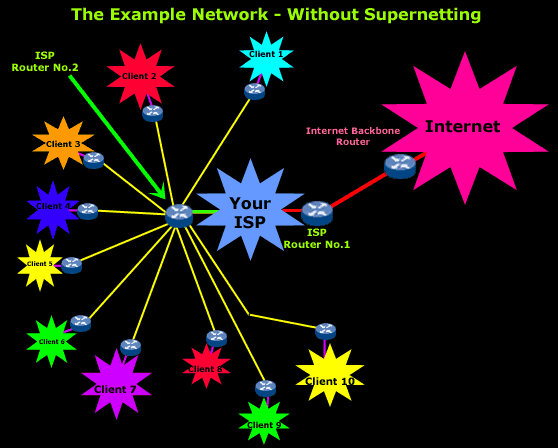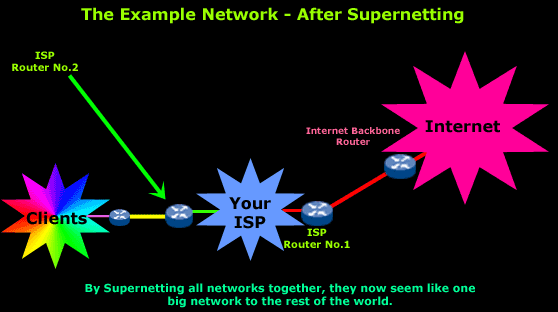What is Supernetting (Route Summarization) & How Supernets Work
Supernetting is the opposite of of subnetting, and is also known as route aggregation or CIDR (Classless Inter-Domain Routing). Supernetting is a technique that allows multiple smaller network blocks to be combined into a larger, more efficient network block. The purpose of supernetting is to reduce the number of routing table entries and minimize the overhead associated with managing multiple routes. By grouping smaller subnets together, supernetting enables more efficient utilization of IP address space and simplifies routing calculations.
Article Key Topics:
- The Purpose of Supernetting - Supernet Example.
- Supernetting Advantages.
- How Supernetting Works - Comparing Supernetting & Subnetting.
- Summary.
Supernetting requires solid understanding of IP, subnetting and binary notation. Read through these sections if in doubt.
The Purpose of Supernetting - Supernet Example
Supernetting exists to address the limitations of the traditional classful addressing scheme. In classful addressing, IP addresses are divided into fixed classes (A, B, C, etc.) with predefined subnet sizes. However, this approach often leads to IP address wastage and inefficient use of available address space. Supernetting, on the other hand, allows for the creation of custom-sized subnets, breaking free from the constraints of classful addressing.
To illustrate supernetting, let's consider an example. Suppose an organization has been assigned the following IP address blocks: 192.168.0.0/24, 192.168.1.0/24, and 192.168.2.0/24. Instead of advertising these three separate /24 networks, supernetting allows us to aggregate them into a single larger network. By applying supernetting, we can represent these networks as a supernet with the address block 192.168.0.0/22. This means that the organization can advertise the supernet address to the external network, simplifying routing tables and reducing overhead.
Let's take a look at second, bigger scale example. The diagram below represents an ISP with multiple customer networks reachable via the internet. Without Supernetting, or Route Summarization, the ISP Router 1 would require one route entry for each client's network:

Taking into consideration ISPs usually have hundreds and thousands of customers, we would need one entry for each of these networks in Router1's routing table. This creates an enourmous requirement in memory and processing power to maintain and update.
Routers 1 & 2 exchange information with each other and update their routing tables. Router 2 connects directly to 10 networks and needs to let Router 1 know about each one of them. Router 1 in turn will also advertise these networks to the internet backbone router so the internet is aware on how to reach these remote networks.
With Supernetting hundreds or thousands of route entries can be theoretically replaced with a single route entry that includes all these remote client networks.
The diagram below visually illustrates this concept. Notice how all client networks have been combined into one larger network:

Even though Router 1 and the internet backbone router summarize all client networks into one (larger) network, Router 2 is still aware of each individual client network.
In conclusion, supernetting is a powerful technique that enables the efficient utilization of IP address space and optimizes routing in networks. By aggregating smaller subnets into larger supernet addresses, organizations can streamline their routing infrastructure and improve overall network performance. Supernetting offers a flexible and scalable solution to address the growing demands of modern networks while maximizing IP address allocation.
Supernetting Advantages
Supernetting has gained significant popularity in the world of networking due to several compelling reasons. Let's delve into why supernetting is widely embraced and valued in the networking community:
- Efficient IP Address Utilization: Supernetting allows for the aggregation of multiple smaller subnets into larger network blocks. This results in more efficient utilization of IP address space. By reducing the number of individual network entries in routing tables, supernetting helps conserve IP addresses, particularly in environments where address shortages are a concern.
- Simplified Routing Infrastructure: Supernetting simplifies routing tables by minimizing the number of route entries. Instead of advertising multiple smaller subnets, a supernet can represent those subnets as a single entry. This simplification improves the efficiency of routing protocols and reduces the complexity associated with managing and updating routing tables.
- Improved Routing Convergence: With supernetting, routing convergence becomes faster and more efficient. By summarizing multiple routes into a single supernet entry, routing protocols can converge more quickly as they only need to consider and update a smaller number of summarized routes. This contributes to reduced network convergence times, which is crucial for maintaining optimal network performance.
- Enhanced Network Security: Supernetting helps improve network security by reducing the exposure of specific network details to external entities. By advertising a supernet address instead of individual subnets, network administrators can hide the internal network structure and make it more challenging for potential attackers to gain insights into the network's internal topology.
- Scalability and Manageability: Supernetting enhances network scalability by reducing the size and complexity of routing tables. As networks grow in size and complexity, the management of routing information becomes more challenging. Supernetting provides a scalable solution by consolidating multiple subnets into summarized routes, easing the burden on routers and network administrators.
We can see that Supernetting provides a wide-ranging advantages, and is therefore no seceret why it has become a fundamental technique for optimizing network performance and addressing the challenges posed by the growth and complexity of modern networks.
How Supernetting Works
As mentioned at the beginning of our article, Supernets are the opposite of Subnets in that they combine multiple Class C networks into blocks rather than dividing them into segments.
With the Subnetting process, we borrow bits from the Host ID portion, which increases the number of bits used for the Network ID portion. With Supernetting we perform the opposite, meaning we take the bits from the Network ID portion and give them to the Host ID portion, as illustrated in the picture below:

Our article Supernetting In-Depth Analysis shows how to calculate supernets by converting IP addresses from decimal to binary format and applying subnetmasks.
Summary
This article explained the concept of Supernetting and provided a few examples to show how its used by organizations to combine multiple networks into one. We also covered the main advantages supernetting provides: efficient IP address utilization, simplified routing infrastructure, improved routing convergence, enhanced network security, scalability and manageability and finally saw how supernetting works.
Wi-Fi Key Generator
Follow Firewall.cx
Cisco Password Crack
Decrypt Cisco Type-7 Passwords on the fly!














